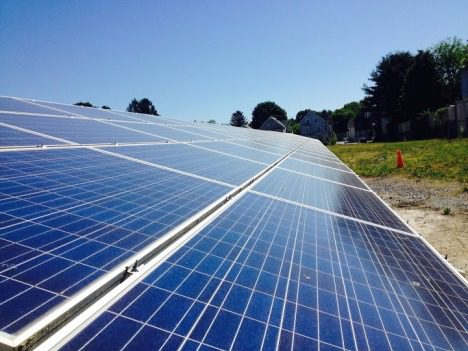
In California, proactive planning for distributed energy resources
Distribution Resource Plans are mandated under Assembly Bill 327, which Governor Jerry Brown signed into law late last year.
Our power system is outdated – and so are the policies that continue to guide its development.But California is making big strides in the right direction.
On November 17, California Public Utilities Commissioner Michael Picker issueddraft guidanceon the implementation of Distribution Resource Plans.
Distribution Resource Plans (commonly known as DRPs) are mandated under Assembly Bill 327, which Governor Jerry Brown signed into law late last year. This law requires investor owned utilities in California to do what every utility should be doing: proactively planning distribution grids for increased deployment of distributed energy resources.
 The primary intent of AB 327 is to support California’s statewide energy and environmental goals, including its 2020 and 2050 greenhouse gas emission reduction targets. Through this legislation, utilities must identify optimal locations for the deployment of distributed energy resources (DER), such as distributed generation, advanced inverters, energy storage, and electric vehicles.
The primary intent of AB 327 is to support California’s statewide energy and environmental goals, including its 2020 and 2050 greenhouse gas emission reduction targets. Through this legislation, utilities must identify optimal locations for the deployment of distributed energy resources (DER), such as distributed generation, advanced inverters, energy storage, and electric vehicles.
To realize mass deployment of DER, the DRPs will guide grid modernization to enable bi-directional power flows, allow greater consumer participation in providing grid services, and create functional markets that appropriately compensate distributed resource owners for the full value of services provided.
According to Commissioner Picker, AB 327’s unprecedented focus on distribution grid planning may lead to the “creation of a new industry model for full and interactive integration of distributed energy resources at a level previously unimagined”.
A new framework for grid planning
The Clean Coalition has long argued that traditional utility distribution system grid planning is inadequate – in terms of visibility and coordination with state policies – to support deployment of DER and other emerging technologies.
The DRP approach builds upon years of Clean Coalition work and incorporates recommendations from our filings (hereandhere) to significantly improve distribution grid planning.
The draft compliance guidelines require utilities to provide DRPs that include three new analytical frameworks to inform DER planning efforts:
- Grid integration capacity:The DRPs must detail the ability of the existing grid to accommodate some amount of DER within the distribution network. Grid maps, with detail down to the circuit level, will be made publicly available.
- Locational value:Utilities must quantify the net benefit, in a given location, DER can provide. All utilities must adopt a unified methodology to assess locational value of DER that considers a variety of criteria, including avoided transmission and distribution grid investments, gains in distribution system operational efficiency, and increased reliability.
- Growth scenarios:Utilities will create three, ten-year scenarios that project high-growth deployment of DER through 2025, with details on expected siting at the distribution substation level and impacts on distribution planning.
Through the DRP requirements to analyze grid integration capacity, locational value, and growth scenarios, the CPUC is following our methodology to lay the foundation for a distribution grid that is “plug-and-play” for DER.
Putting planning into practice
As part of the DRP process, utilities must demonstrate the integration of locational benefits analysis into distribution planning and operations.
An analysis methodology to determineoptimal locationsfor DER is required in the DRPs. Having drafted legislation and policy briefs that address distribution grid planning, distributed generation, and ratepayer benefits since mid-2011, the Clean Coalition has long advocated for DRPs and offered practical criteria for defining optimal locations for DER. Commissioner Picker’s draft guidance encapsulates many of our long-standing recommendations, such as the need to identify the “carrying capacity for DER” at locations on the grid and cross reference this information with grid locations where deferral or avoidance of costly distribution and transmission grid upgrades can be realized by targeted and coordinated development of specific DER capacities.
Building upon the optimal locations benefits analysis methodology, each utility must design a substation level project that will demonstrate distribution grid operations at high levels of DER. This substation level approach aligns with ourHunters Point Community Microgrid Project, being conducted in collaboration with Pacific Gas & Electric in San Francisco, California. Through this project, we have developed a scalable and replicable methodology for optimizing the deployment of DER within a substation – and have strongly argued for DER incorporation into distribution planning.
These demonstration projects, which must be ready to begin within one year of CPUC approval of the utility’s DRP, require customer and/or third party owned DER. The utility is responsible for defining the transaction method, such as standard tariffs or competitive contracts.
It is worth noting that any new or modified tariffs and contracts will be applicable only to the demonstration projects. The DRP process, as stated in Commissioner Picker’s draft guidance, is not the forum to adopt new tariffs. However, recommendations regarding the locational benefit component of DER may be ripe for inclusion in multiple proceedings, such as the NEM successor rulemaking. Furthermore, per the Clean Coalition’s recommendations, the market mechanisms used in the demonstration projects should inform any future modifications to existing utility tariffs and contracts, and the DRP filings will be coordinated with general rate cases.
Comments on the draft guidance are due December 12, 2014, and a final ruling is expected by January 2015. Utilities’ first DRPs are due by July 1, 2015, and moving forward, DRPs will be filed on a biennial cycle for at least 10 years.

